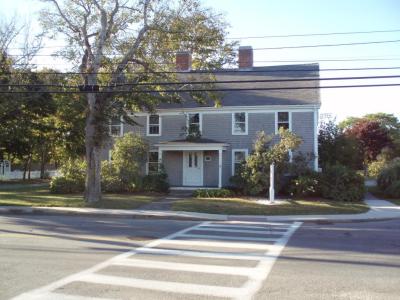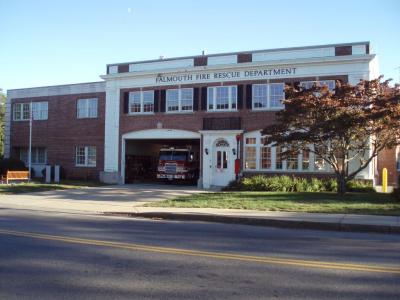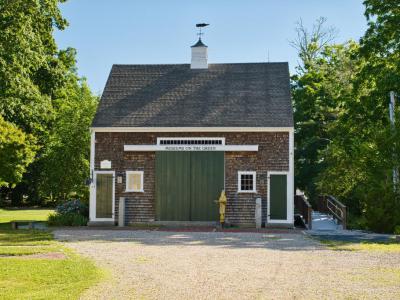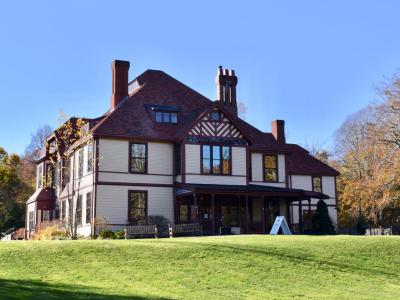
Falmouth Introduction Walking Tour (Self Guided), Falmouth
Nestled at the southwestern tip of Cape Cod, Falmouth, Massachusetts, is a picturesque coastal town brimming with natural beauty and historical charm. Founded in 1686, the town was named after Falmouth in Cornwall, England. Historically, it thrived on farming, saltworks, shipping, whaling, and wool processing, aided by the introduction of Merino sheep. During the War of 1812, Falmouth Heights faced a brief bombardment by British forces.
The arrival of the railroad in 1872 spurred summer home development and agricultural shifts, with cranberries and strawberries becoming significant crops. Highfield Hall, built in the late 1800s, stands as a testament to that era’s affluence.
The town's population growth surged after World War II due to improved highways and nearby military activity.
Today, Main Street serves as the heart of Falmouth, showcasing a blend of the old and the new. Lined with quaint shops, restaurants, and historic landmarks, it’s a place where the town’s charm truly comes alive. Nearby, the Poor House and Methodist Cemetery stand as reminders of the town’s early efforts to care for its community, with graves dating back to the 1800s.
The Central Fire Station, built in the first half of the 20th century, is a notable piece of Falmouth’s architectural heritage. Just a short stroll away is the Falmouth Public Library, an institution that has been a hub for learning and culture since its establishment.
Lawrence Academy, originally a private school in the 19th century, also reflects the town’s dedication to education. Equally significant is Saint Barnabas's Church, a striking Gothic Revival structure that has served the community's spiritual needs for over a century.
For history enthusiasts, the Falmouth Museums on the Green offer a deep dive into the town’s past. Exhibits include artifacts from its maritime heritage and colonial days, all housed in well-preserved historic buildings.
If you’re looking for a destination that blends history, natural beauty, and a sense of community, Falmouth is a perfect choice. Explore its historic sites and immerse yourself in the stories that make this Cape Cod town unique. Visit today and discover why Falmouth remains a cherished place for residents and visitors alike!
The arrival of the railroad in 1872 spurred summer home development and agricultural shifts, with cranberries and strawberries becoming significant crops. Highfield Hall, built in the late 1800s, stands as a testament to that era’s affluence.
The town's population growth surged after World War II due to improved highways and nearby military activity.
Today, Main Street serves as the heart of Falmouth, showcasing a blend of the old and the new. Lined with quaint shops, restaurants, and historic landmarks, it’s a place where the town’s charm truly comes alive. Nearby, the Poor House and Methodist Cemetery stand as reminders of the town’s early efforts to care for its community, with graves dating back to the 1800s.
The Central Fire Station, built in the first half of the 20th century, is a notable piece of Falmouth’s architectural heritage. Just a short stroll away is the Falmouth Public Library, an institution that has been a hub for learning and culture since its establishment.
Lawrence Academy, originally a private school in the 19th century, also reflects the town’s dedication to education. Equally significant is Saint Barnabas's Church, a striking Gothic Revival structure that has served the community's spiritual needs for over a century.
For history enthusiasts, the Falmouth Museums on the Green offer a deep dive into the town’s past. Exhibits include artifacts from its maritime heritage and colonial days, all housed in well-preserved historic buildings.
If you’re looking for a destination that blends history, natural beauty, and a sense of community, Falmouth is a perfect choice. Explore its historic sites and immerse yourself in the stories that make this Cape Cod town unique. Visit today and discover why Falmouth remains a cherished place for residents and visitors alike!
How it works: Download the app "GPSmyCity: Walks in 1K+ Cities" from Apple App Store or Google Play Store to your mobile phone or tablet. The app turns your mobile device into a personal tour guide and its built-in GPS navigation functions guide you from one tour stop to next. The app works offline, so no data plan is needed when traveling abroad.
Falmouth Introduction Walking Tour Map
Guide Name: Falmouth Introduction Walking Tour
Guide Location: USA » Falmouth (See other walking tours in Falmouth)
Guide Type: Self-guided Walking Tour (Sightseeing)
# of Attractions: 8
Tour Duration: 2 Hour(s)
Travel Distance: 3.0 Km or 1.9 Miles
Author: nataly
Sight(s) Featured in This Guide:
Guide Location: USA » Falmouth (See other walking tours in Falmouth)
Guide Type: Self-guided Walking Tour (Sightseeing)
# of Attractions: 8
Tour Duration: 2 Hour(s)
Travel Distance: 3.0 Km or 1.9 Miles
Author: nataly
Sight(s) Featured in This Guide:
- Main Street
- Poor House and Methodist Cemetery
- Central Fire Station
- Public Library
- Lawrence Academy
- Saint Barnabas's Church
- Falmouth Museums on the Green
- Highfield Hall and Gardens
1) Main Street (must see)
Main Street is a vibrant and picturesque hub, celebrated as one of Cape Cod's finest destinations for shopping, dining, and exploring. Lined with historic 19th-century buildings, the street exudes charm and character, offering a delightful mix of unique storefronts. Visitors can browse everything from gift and home décor shops like Twigs and Homespun Garden to jewelry boutiques and the beloved Eight Cousins Books. Alongside shopping, Main Street boasts culinary delights, from American gastropubs to international flavors, with popular spots like Pickle Jar Kitchen and Estia. For sweet treats, Ben & Bill’s Chocolate Emporium is a favorite stop, serving ice cream and handmade candies.
This walkable downtown area seamlessly blends history with modern attractions. The Falmouth Museums on the Green, located right on Main Street, provide an engaging look into the town’s rich past through exhibits and events. Nearby, the Village Green is surrounded by majestic homes with Colonial and Federalist architecture, while the First Congregational Church’s bell, cast by Paul Revere, rings out on the hour. Patty Noonan Park on Main Street offers free summer movies, adding to the lively atmosphere. Just a short distance away, Queens Buyway presents additional boutique shopping and a charming café experience.
Beyond shopping and dining, Main Street’s proximity to natural beauty and cultural landmarks makes it an ideal destination. From the scenic Surf Drive Beach with views of Vineyard Sound to the Falmouth Harbor, where a ferry awaits to take visitors to Martha’s Vineyard, there’s plenty to explore.
This walkable downtown area seamlessly blends history with modern attractions. The Falmouth Museums on the Green, located right on Main Street, provide an engaging look into the town’s rich past through exhibits and events. Nearby, the Village Green is surrounded by majestic homes with Colonial and Federalist architecture, while the First Congregational Church’s bell, cast by Paul Revere, rings out on the hour. Patty Noonan Park on Main Street offers free summer movies, adding to the lively atmosphere. Just a short distance away, Queens Buyway presents additional boutique shopping and a charming café experience.
Beyond shopping and dining, Main Street’s proximity to natural beauty and cultural landmarks makes it an ideal destination. From the scenic Surf Drive Beach with views of Vineyard Sound to the Falmouth Harbor, where a ferry awaits to take visitors to Martha’s Vineyard, there’s plenty to explore.
2) Poor House and Methodist Cemetery
The Poor House and Methodist Cemetery is a historic site with deep ties to the town's social history. Established in 1809, the Poor House opened its doors in 1812 to provide shelter and care for the poor and mentally ill, serving this purpose for over 150 years until 1963.
After its closure as a poor house, the building, now called the Edward Marks Jr. Building, transitioned to other uses. Over the years, it has housed the Falmouth Retirement System and the Falmouth Historical Commission, reflecting its evolving role in the community. The property also became a creative hub for local artists when it served as the home of the Falmouth Artists Guild, prior to the construction of the Falmouth Art Center.
Adjacent to the Poor House is the Methodist Cemetery, also known by various names such as the "Old Methodist Cemetery" and the "Falmouth Poor House Burial Ground," where many of the Poor House's residents were laid to rest. Both the Poor House and cemetery were recognized for their historical significance and added to the National Register of Historic Places in 1998.
After its closure as a poor house, the building, now called the Edward Marks Jr. Building, transitioned to other uses. Over the years, it has housed the Falmouth Retirement System and the Falmouth Historical Commission, reflecting its evolving role in the community. The property also became a creative hub for local artists when it served as the home of the Falmouth Artists Guild, prior to the construction of the Falmouth Art Center.
Adjacent to the Poor House is the Methodist Cemetery, also known by various names such as the "Old Methodist Cemetery" and the "Falmouth Poor House Burial Ground," where many of the Poor House's residents were laid to rest. Both the Poor House and cemetery were recognized for their historical significance and added to the National Register of Historic Places in 1998.
3) Central Fire Station
Constructed in 1929, the Central Fire Station's two-story brick structure showcases the architectural finesse of Fitchburg architects Haynes & Mason. The building’s design is marked by the elegant use of Flemish bond brickwork, complemented by wooden quoins that accentuate its corners. Its central doorway, framed by pilasters and topped with a fanlight, serves as a charming focal point.
Adjacent to the entrance, the truck bay on the left and a group of five sash windows on the right feature matching low arched finishes with keystone details, adding symmetry and refinement to the facade. The flat roof, discreetly concealed by a low parapet, enhances the building's clean, streamlined appearance.
Beyond its architectural significance, the Central Fire Station holds historical importance as a community landmark. Listed on the National Register of Historic Places in 1998, the station stands as a testament to Falmouth’s dedication to preserving its heritage.
Adjacent to the entrance, the truck bay on the left and a group of five sash windows on the right feature matching low arched finishes with keystone details, adding symmetry and refinement to the facade. The flat roof, discreetly concealed by a low parapet, enhances the building's clean, streamlined appearance.
Beyond its architectural significance, the Central Fire Station holds historical importance as a community landmark. Listed on the National Register of Historic Places in 1998, the station stands as a testament to Falmouth’s dedication to preserving its heritage.
4) Public Library
The Falmouth Public Library is a historic and cultural gem in the heart of Falmouth Village. Constructed in 1901 and renovated in 2008, this two-story building combines its rich heritage with modern amenities. It serves as a vibrant community hub, offering a welcoming environment for visitors of all ages.
The library is renowned for its dedication to history and genealogy, housing an extensive collection in the Lemcke Reference Room. Patrons can explore local history materials, some of which date back to the 18th-century Falmouth Library Society, or participate in the weekly drop-in sessions hosted by the Falmouth Genealogical Society. Notably, the library honors Katharine Lee Bates, the Falmouth-born poet best known for "America the Beautiful," with a representative collection of her works on display.
The iconic building that houses the library today was constructed by the Beebe family, prominent local philanthropists whose wealth originated from their Boston department store. This historic structure was dedicated as a memorial to Falmouth soldiers and sailors who served in the Revolutionary and Civil Wars, underscoring its deep ties to the community's history. The library's architecture is a testament to its legacy, featuring a striking central dome adorned with a stained-glass seal of Falmouth—a detail not to be missed when entering the building.
The library is renowned for its dedication to history and genealogy, housing an extensive collection in the Lemcke Reference Room. Patrons can explore local history materials, some of which date back to the 18th-century Falmouth Library Society, or participate in the weekly drop-in sessions hosted by the Falmouth Genealogical Society. Notably, the library honors Katharine Lee Bates, the Falmouth-born poet best known for "America the Beautiful," with a representative collection of her works on display.
The iconic building that houses the library today was constructed by the Beebe family, prominent local philanthropists whose wealth originated from their Boston department store. This historic structure was dedicated as a memorial to Falmouth soldiers and sailors who served in the Revolutionary and Civil Wars, underscoring its deep ties to the community's history. The library's architecture is a testament to its legacy, featuring a striking central dome adorned with a stained-glass seal of Falmouth—a detail not to be missed when entering the building.
5) Lawrence Academy
The Lawrence Academy is a striking example of Greek Revival architecture and a cherished piece of the town's history. Built in 1834, this 2½-story wood-frame structure is distinguished by its elegant design, featuring a front-gabled roof and a Greek temple-style portico.
The portico is adorned with an entablature and a gabled pediment supported by four Ionic columns, while the flushboarded pediment boasts a modillioned cornice and eaves, lending the building a stately presence. Atop the structure is a two-stage bell tower, reconstructed based on historic photographs. The lower stage is square and clapboarded with a modillioned cornice, while the upper stage features an octagonal belfry, adding a distinctive element to the building's silhouette.
Initially established as a private academy, Lawrence Academy played a significant role in Falmouth’s educational landscape. From 1891 to 1895, it served as the town's high school before transitioning into a civic hall, where it became a hub for veterans' organizations and community activities. Over the years, its function has evolved, but its historical significance remains intact. Today, it houses the Falmouth Chamber of Commerce, continuing to serve as a focal point for the community while preserving its historical essence.
In recognition of its architectural and historical value, Lawrence Academy was listed on the National Register of Historic Places in 1998.
The portico is adorned with an entablature and a gabled pediment supported by four Ionic columns, while the flushboarded pediment boasts a modillioned cornice and eaves, lending the building a stately presence. Atop the structure is a two-stage bell tower, reconstructed based on historic photographs. The lower stage is square and clapboarded with a modillioned cornice, while the upper stage features an octagonal belfry, adding a distinctive element to the building's silhouette.
Initially established as a private academy, Lawrence Academy played a significant role in Falmouth’s educational landscape. From 1891 to 1895, it served as the town's high school before transitioning into a civic hall, where it became a hub for veterans' organizations and community activities. Over the years, its function has evolved, but its historical significance remains intact. Today, it houses the Falmouth Chamber of Commerce, continuing to serve as a focal point for the community while preserving its historical essence.
In recognition of its architectural and historical value, Lawrence Academy was listed on the National Register of Historic Places in 1998.
6) Saint Barnabas's Church
Saint Barnabas's Church is a historic gem founded in 1888 by E. Pierson Beebe and his siblings as a memorial to their parents. The cornerstone of the church was laid on June 11, 1889—Saint Barnabas’s Feast Day—which inspired the church’s name. Designed by English architect Henry Vaughn, the granite structure with mountain meadow red sandstone trim was completed in June 1890. Reflecting the English village style, the church combines aesthetic charm with symbolic design elements, including a cruciform layout and a nave reminiscent of the underside of a boat, evoking early Christian worship practices beneath overturned vessels for shelter.
The church’s interior is rich with meaningful artistry, starting with the intricately stenciled chancel ceiling. Six repeating patterns, attributed to Henry Vaughn, depict key symbols of Christian faith, including the crown of thorns, Greek letters for Jesus and Christ, and instruments of the crucifixion such as the ladder and hammer. The High Altar window, crafted by Boston-based Heaton, Butler, and Byrne, illustrates the Ascension of Christ, flanked by his eleven apostles, and is the earliest of the church’s windows. The Te Deum window over the front entrance, added in 1964, commemorates Reverend Wallace, a former rector, while the stained-glass windows throughout the church were created by Charles E. Kempe’s studio in England, identifiable by the golden sheaves of wheat in the lower left corner.
The architectural and symbolic details of Saint Barnabas’s Church embody a deep connection to faith and heritage. Visitors can admire its plain walls, symbolizing Christianity’s strength and permanence, interspersed with narrow stained-glass windows that narrate biblical stories and values. From the eagle-shaped lectern inspired by verses from Isaiah to the historical lineage of Barnabas Beebe, the church offers a profound spiritual and historical experience, seamlessly blending artistry, history, and devotion.
The church’s interior is rich with meaningful artistry, starting with the intricately stenciled chancel ceiling. Six repeating patterns, attributed to Henry Vaughn, depict key symbols of Christian faith, including the crown of thorns, Greek letters for Jesus and Christ, and instruments of the crucifixion such as the ladder and hammer. The High Altar window, crafted by Boston-based Heaton, Butler, and Byrne, illustrates the Ascension of Christ, flanked by his eleven apostles, and is the earliest of the church’s windows. The Te Deum window over the front entrance, added in 1964, commemorates Reverend Wallace, a former rector, while the stained-glass windows throughout the church were created by Charles E. Kempe’s studio in England, identifiable by the golden sheaves of wheat in the lower left corner.
The architectural and symbolic details of Saint Barnabas’s Church embody a deep connection to faith and heritage. Visitors can admire its plain walls, symbolizing Christianity’s strength and permanence, interspersed with narrow stained-glass windows that narrate biblical stories and values. From the eagle-shaped lectern inspired by verses from Isaiah to the historical lineage of Barnabas Beebe, the church offers a profound spiritual and historical experience, seamlessly blending artistry, history, and devotion.
7) Falmouth Museums on the Green (must see)
The Falmouth Museums on the Green offer an immersive exploration of Falmouth’s rich history and culture. Overlooking the historic Village Green, where Colonial militia once practiced and sea captains built their homes, the museum campus spans two acres and includes two 18th-century houses filled with period furniture, fine art, textiles, and rotating exhibits. Operated by the Falmouth Historical Society—Cape Cod’s oldest historical organization, established in 1900—the museums provide a glimpse into the lives of early residents while preserving the town’s unique heritage.
Among the highlights is the 1790 Dr. Francis Wicks House, a Federalist-period residence that vividly portrays the lifestyle of an affluent doctor during the late 18th and early 19th centuries. The 1730 Conant House, recently restored, serves as both exhibit space and headquarters for the Historical Society. The Hallett Barn Visitors’ Center welcomes guests and features the “Whaling Wives Gift Shop.” The campus also includes the Colonial Gardens, which showcase plants dating back to the pre-Revolutionary era and are meticulously maintained by the Falmouth Garden Club, and Memorial Park, a serene space for reflection.
The Museums on the Green continue to evolve as a cultural and educational hub. The 2012 Cultural Center, a 3,600-square-foot facility, hosts public and private programs, events, and archival collections. Visitors can delve deeper into Falmouth and Cape Cod’s history through the extensive research library, which supports genealogy studies and historical inquiries. Whether exploring artifacts, enjoying the tranquil gardens, or attending events in the Cultural Center, the Falmouth Museums on the Green provide an enriching experience that connects the past with the present.
Among the highlights is the 1790 Dr. Francis Wicks House, a Federalist-period residence that vividly portrays the lifestyle of an affluent doctor during the late 18th and early 19th centuries. The 1730 Conant House, recently restored, serves as both exhibit space and headquarters for the Historical Society. The Hallett Barn Visitors’ Center welcomes guests and features the “Whaling Wives Gift Shop.” The campus also includes the Colonial Gardens, which showcase plants dating back to the pre-Revolutionary era and are meticulously maintained by the Falmouth Garden Club, and Memorial Park, a serene space for reflection.
The Museums on the Green continue to evolve as a cultural and educational hub. The 2012 Cultural Center, a 3,600-square-foot facility, hosts public and private programs, events, and archival collections. Visitors can delve deeper into Falmouth and Cape Cod’s history through the extensive research library, which supports genealogy studies and historical inquiries. Whether exploring artifacts, enjoying the tranquil gardens, or attending events in the Cultural Center, the Falmouth Museums on the Green provide an enriching experience that connects the past with the present.
8) Highfield Hall and Gardens (must see)
Highfield Hall and Gardens is a historic and cultural treasure set amidst 400 acres of conservation land. Originally built in 1878 as the summer home of the Beebe family, the mansion has been meticulously restored and transformed into a vibrant community and cultural center. Visitors can explore the estate’s lush grounds, which include beautifully landscaped gardens, peaceful walking trails, and Beebe Woods—a network of trails and old carriage roads. The estate offers a tranquil escape and invites guests to enjoy picnics in the gardens or docent-led tours of the mansion.
The Hall serves as a hub of cultural activity, hosting concerts, art exhibits, and educational programs for all ages throughout the year. The two meticulously restored gardens add to the estate’s charm, showcasing a stunning array of flora and reflecting the property’s historical elegance. Highfield Hall’s vibrant history, including its dramatic rescue from demolition in 1994 and subsequent reopening as a museum and cultural site in 2006, highlights the community's dedication to preserving its heritage.
As a five-star rated destination, Highfield Hall and Gardens combines history, art, and nature to offer a unique experience for visitors. Whether walking the scenic trails, attending engaging events, or marveling at the mansion’s Victorian architecture, guests can immerse themselves in Falmouth’s cultural legacy.
The Hall serves as a hub of cultural activity, hosting concerts, art exhibits, and educational programs for all ages throughout the year. The two meticulously restored gardens add to the estate’s charm, showcasing a stunning array of flora and reflecting the property’s historical elegance. Highfield Hall’s vibrant history, including its dramatic rescue from demolition in 1994 and subsequent reopening as a museum and cultural site in 2006, highlights the community's dedication to preserving its heritage.
As a five-star rated destination, Highfield Hall and Gardens combines history, art, and nature to offer a unique experience for visitors. Whether walking the scenic trails, attending engaging events, or marveling at the mansion’s Victorian architecture, guests can immerse themselves in Falmouth’s cultural legacy.
The Most Popular Cities
/ view all







